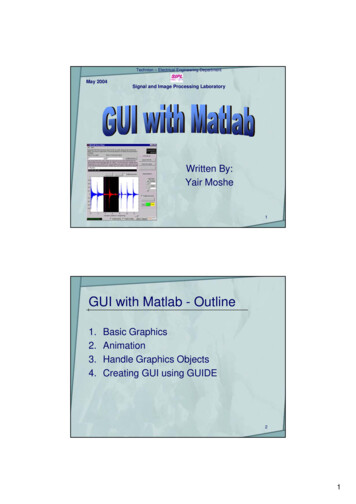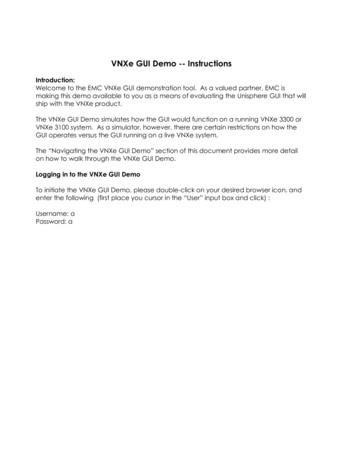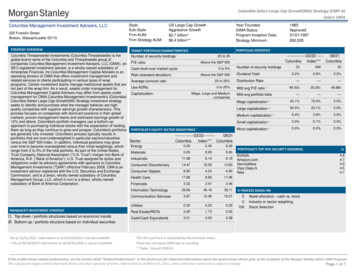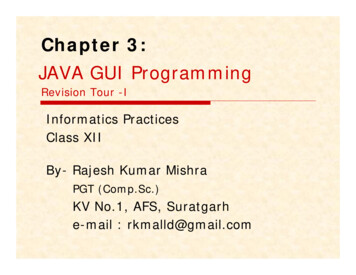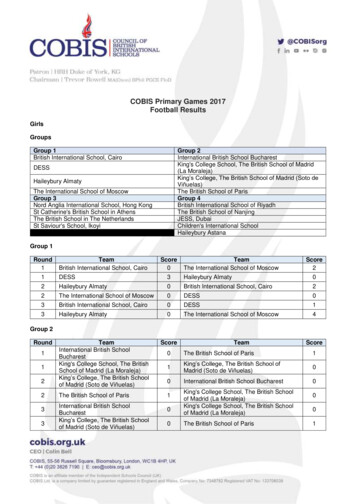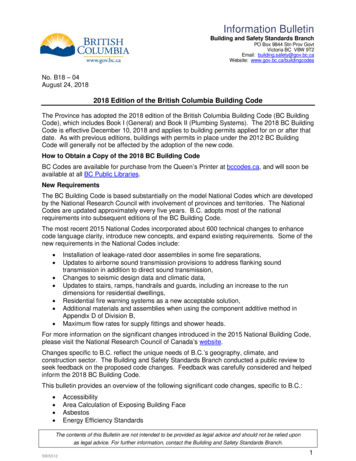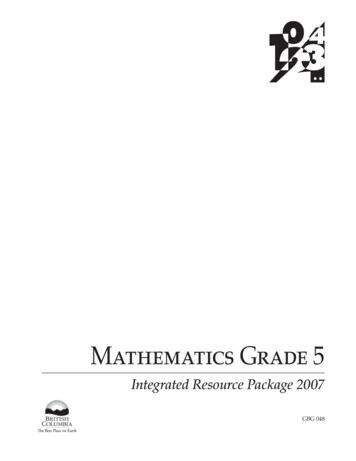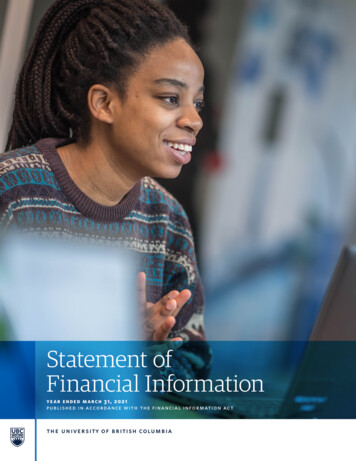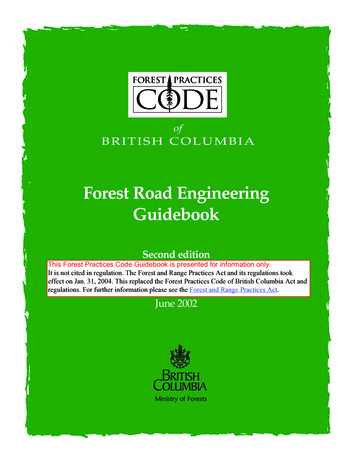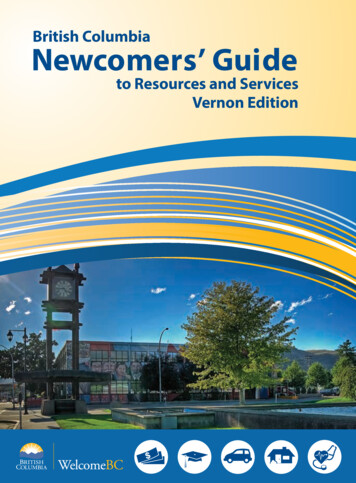
Transcription
British ColumbiaNewcomers’ Guideto Resources and ServicesVernon Edition
Please note2014 Vernon Edition: The information in this guide is up to date at the time of printing. Names, addressesand telephone numbers may change, and publications go out of print, without notice. For more up-to-dateinformation, please visit: www.welcomebc.caThis guide has been written using the Canadian Language Benchmark 4 (CLB 4) level to meet the needsof non-English speaking newcomers.To order copies of theProvincial Newcomers’ GuideAcknowledgements(2014 Edition)The Vernon edition of the BC Newcomers’ Guideis available online at www.welcomebc.ca. Printcopies may be available through Vernon and DistrictImmigrant Services Society www.vdiss.com Shelley Motz and Timothy Tucker, Project ManagersPrint copies of the provincial guide are available freeof charge while quantities last. The provincial guideis also available online in the following languages:Arabic, Chinese (Simplified), Chinese (Traditional),Farsi (Persian), French, Korean, Punjabi, Russian,Spanish and Vietnamese. Reber Creative, Design Update and LayoutYou can order copies of the provincial guide by fillingin the resource order form at: www.welcomebc.ca/newcomers guide/newcomerguide.aspx. You can alsorequest copies by telephone or e-mail. Please includeyour contact name, address, postal code and phonenumber with “B.C. Newcomers’ Guide - English#7550001438” in the subject line.Ministry of Jobs, Tourism and Skills Training3rd Floor, 1106 Cook StreetVictoria, B.C. V8W 9J1Metro Vancouver: 604 660-2421Victoria: 250 387-6121Toll-free: 1 800 663-7867E-mail: DCVCustomerSer@gov.bc.caThank youThe British Columbia Newcomers’ Guide to Resources andServices would not be possible without the help of allthe individuals, agencies and government organizationswho contributed to the guide.The 2012 Vernon Edition was made possible dueto the efforts and support of Kevin Poole, Managerof Economic Development, City of Vernon; RobertMiles, Planning Assistant, City of Vernon; AnnetteSharkey, Executive Director, Social Planning Councilfor the North Okanagan.Cover photo: Steve Austin Photography & Design Barbara Carver, Baytree Communications,Project Coordinator and Editor Brigitt Johnson, 2014 Update Consultant Andrea Scott, Big Red Pen, Proofreading Gillian Ruemke-Douglas and Nola Johnston,IllustrationsLibrary and Archives CanadaCataloguing in Publication DataMain entry under title:British Columbia newcomers’ guide to resourcesand services. -- June 1999Irregular.“Immigrant settlement”.Issued also in multiple other language eds.Issued also on the Internet.Imprint varies.ISSN 1493-8065 British Columbia newcomers’guide to resources and services1. Human services - British Columbia. 2. Immigrants Services for - British Columbia. I. British Columbia.Ministry Responsible for Multiculturalism andImmigration. II. British Columbia. Ministry ofCommunity, Aboriginal and Women’s Services.III. British Columbia. Welcome BC.HV4013.B74361.9711C00-801748-4
British ColumbiaNewcomers’ Guideto Resources and ServicesVernon Edition2014
Welcome to British Columbia!Every year we welcome more than 40,000 new immigrantsto beautiful British Columbia, a place where newcomersfrom around the world are choosing to live, work and raisetheir families.In B.C., we are putting families first, and part of our jobis to ensure that you feel at home and have access to theresources and services you need to thrive in our province.To help you, we are happy to offer you the 2014 British Columbia Newcomers’Guide to Resources and Services. Previous editions of the Newcomers’ Guidehave helped many new immigrants over the years, and I know it will help youand your family find the information and services you need so that you canconfidently settle in your new home – British Columbia.Inside this guide you’ll find important information about topics such ashousing, banking, health care, education, driving, employment and business,the legal system, government, citizenship and much more.Immigrants play an important role in British Columbia, and I welcomeyou to our province. I wish you well in your journey to settle and adapt toyour new life.Thank you for choosing British Columbia as your new home.Honourable Shirley BondMinister of Jobs, Tourism and Skills Training and Responsible for Labour
On behalf of Vernon City Council, I would like to welcomeyou to our community. I believe you will find that Vernon is apleasant, safe and exciting city to live and work. I have lived andworked as a family doctor in Vernon for over 20 years. I grew upin Saskatchewan, but my wife Betsy and I chose to raise our twochildren here in Vernon.Vernon is a diverse community, made up of people from all overthe world. You will find that there are many support services fornew residents, including business services, job finding services andprograms for families. Our community is ready to help you transition into this new life.We offer a wide variety of housing types to choose from. Whether you are looking for anapartment in our vibrant city centre, a house with a view of the lake or something in between,you will find something that meets your needs in Vernon. We also have an excellent educationsystem which includes post-secondary opportunities at the University of British ColumbiaOkanagan and Okanagan College. Health care in Vernon is easily accessed with your choiceof doctors, and Vernon Jubilee Hospital is centrally located in town.Recreational activities include water-based sports, golf, cycling, hiking and mountain biking.In winter, Silver Star and Sovereign Lake Nordic Centre provide world class alpine andnordic skiing. Vernon also offers a wide range of cultural amenities, including the Vernon andDistrict Performing Arts Centre, a new Regional Library and a number of destinations thatshow off our vibrant artistic community and our rich history.Very few places can offer our combination of climate, geography, education, lifestyle,multiculturalism, and business support services. I hope that you find it as great a placeto live as I have.Sincerely,Rob SawatzkyMayor
TableTableofofContentsContentsVIUsing the B.C. Newcomers’ Guide 1Chapter 1: About British Columbia and Vernon 2Chapter 2: The First Few Days 9Chapter 3: Finding a Place to Live 25Chapter 4: Money and Banking 36Chapter 5: Health Care 42Chapter 6: Education 50Chapter 7: Help for Individuals and Families 60Chapter 8: Cars and Driving 74b R I T I S H C O L U M B I A n e w com e rs ’ g ui d e to r e sourc e s a n d s e r v ic e s
Table of ContentsChapter 9: Employment and Business 85Chapter 10: The Legal System 99Chapter 11: Government and Citizenship 107Chapter 12: Community, Culture and Sports 115Chapter 13: Environment 122Abbreviations and Acronyms 128Index 129Questionnaire 133VII
Welcome to British ColumbiaSky High PhotographyWelcome to British Columbia (B.C.). Many peoplehave come to B.C. from all over the world.They have settled and made new lives here.Newcomers have been very important in B.C.’shistory, growth, and development.VIIIb R I T I S H C O L U M B I A n e w com e rs ’ g ui d e to r e sourc e s a n d s e rvic e s
Using the B.C. Newcomers’ GuideUsing theB.C. Newcomers’ GuideThe British Columbia Newcomers’ Guide,Vernon Edition has information that will helpyou settle in B.C. in the first few monthsafter you arrive. Each chapter providesinformation and the names of agenciesand services to help you. Use the chapterheadings, such as Finding a Place to Live,Health Care, and Employment and Business,to help you find the information you need.At the end of most chapters, there is a listof agencies where you can get help or moreinformation. The index at the end of theguide will also help you find information.Some of the information – for example, names,telephone numbers, and addresses – may havechanged since this guide was published.All websites are in English. Some may also bein other languages.Please refer to the map of Metro Vancouver onpage 2 or the map of British Columbia at theback of this guide for the city, town, or regionnames in English.Newcomers’ Guide VideosThere are Newcomers’ Guide videos onthe WelcomeBC website. These videoshave more information on some of thetopics covered in this guide. The videosare available in 11 different languages.To view the videos online, go to:www.welcomebc.ca or scan theQuick Response (QR) codes to viewthem on your smartphone. Learn moreabout QR codes below.Throughout the guide, you will see symbols like this one next to some topics.These are QR codes that you can scan with your smartphone using softwaresuch as ScanLife. When you scan a QR code, it will play the Newcomers’ Guidevideo for that topic on your smartphone. If you do not have a QR code readeron your smartphone, go to: www.getscanlife.com from your mobile browserto download the free application. Standard data usage rates apply.1
Chapter 1: About British Columbia and Vernon Major cities Geography Time zones Climate Industry B.C.’s first people SettlersPictureBC Where to go forinformationWelcome to British Columbia (B.C.). Manypeople have come to B.C. from all over theworld. They have settled and made new liveshere. Newcomers have been very importantin B.C.’s history, growth and development.Canada has about 34 million people. About4.6 million people live in British Columbia(B.C.). Canada has two official languages:English and French. In B.C. most peoplespeak English.B.C. is one of Canada’s 10 provinces. It isa very large province—larger than manyMap of Metro VancouverWESTVANCOUVERNORTH VANCOUVERPORT MOODYVANCOUVERBURNABYCOQUITLAMPORTCOQUITLAMPITT WHITE ROCK2LANGLEYcountries in the world. For example, it isfour times larger than Great Britain.B.C. is on the west coast of Canada, betweenthe Rocky Mountains and the Pacific Ocean.It has many mountains, rivers, lakes, andforests.Major citiesMetro Vancouver is the biggest city inBritish Columbia, and the third largest cityin Canada. More than two million peoplelive there, almost half of the population ofthe province. The Metro Vancouver area ismade up 24 separate communities, includingVancouver, North Vancouver, Richmond,Burnaby, Delta, Surrey, Coquitlam, Langley,and Maple Ridge. It is also called the LowerMainland or Greater Vancouver.Victoria is the capital city of B.C. It is onVancouver Island. About 350,000 peoplelive in and around Victoria, and the B.C.government meets here.Prince George is the largest city in northernBritish Columbia. It provides services toNorthern B.C. About 84,000 people livein Prince George.b R I T I S H C O L U M B I A n e w com e rs ’ g ui d e to r e sourc e s a n d s e rvic e s
About British Columbia and Vernon379777Deas LakeFort NelsonClintonCache CreekKAMLOOPSN EC H A K ON O R THC O A STLoganLakeP E ACE /NO RT HE AS 1637KitimatN EC H A K OHouston66 n Chetwynd37Salmon ArmKelowna5Fort St JohnStewartRevelstokeSicamous976Fort St JamesBurns LakePRINCE C A RIBO O /CE NT RALValemountAnahim LakeAlexis CreekWILLIAMS LAKEVA N C OU VER I SLA N D /C EN TR A L C O A ST97 100 MileHouse24Port McNeillCampbellRiverUcluelet93GoldenLittle Fort5ClintonCache CreekKAMLOOPSLillooetPort HardyTofinoClearwaterT HO MP S O N- O KANAG ANPowellRiverWhistler 99 SicamousSalmon eNakuspKOOTENAYKaslo66 ey3CRANBROOKMAINL AND/S O UT HWE S TVICTORIAVernon is a growing community in the Okanagan Valley. It is surrounded by grasslands, farmsand orchards, forested hills and scenic lakes. About 38,150 people live in the city, and thereare over 83,000 people in the region.Other communities in British Columbia: Kelowna and Penticton are in the Okanagan Valley in the interior of B.C.This part of B.C. is known for growing fruit and producing wine. Kamloops and Williams Lake are in the interior of B.C. Victoria and Nanaimo are on Vancouver Island. Prince Rupert and Terrace are in northwest B.C. Fort St. John and Dawson Creek are in northeast B.C. Cranbrook is in southeast B.C.3
Chapter 1: About British Columbia and VernonGeographyBritish Columbia is on the west coast ofCanada, between the Rocky Mountainsand the Pacific Ocean.Most British Columbians live in thesouthern part of the province, close tothe United States border.The Okanagan Valley runs from Sicamousin the north to the U.S. border in the south.It is known for farming, especially fruit,and wineries.Vernon is one of the oldest cities in theOkanagan Valley. All around there are drygrassland hillsides, forests, the MonasheeMountains and three lakes—Okanagan Lake,Kalamalka Lake and Swan Lake.Vernon’s City Centre is the heart of thecommunity. It has shops, restaurants, offices,apartments and homes in the area.Neighbourhoods like East Hill and MissionHill have historic homes and are close tothe City Centre. Harwood, Alexis Park,and South Vernon are close to schools andshopping destinations. There are many newneighbourhoods on the hillsides. They haveviews of the city and the lake.Colin BaxterIt is a land of mountains, rivers, forests,islands, and coastlines. The Pacific Ocean is tothe west, the Rocky Mountains are in the east,and the United States of America is south.Forests cover most of the province, and muchof British Columbia is wild country.Time zonesLike most of B.C., Vernon is in the PacificTime Zone. The area around Dawson Creekin northeast B.C., and around Cranbrookin southeast B.C., are on Mountain Time.They are one hour ahead of the rest of BritishColumbia.Most of B.C. is on daylight saving time(DST) in the spring and summer. Daylightsaving time begins on the second Sundayin March, when people turn their clocksforward one hour. DST ends on the firstSunday in November, when people turn theirclocks back one hour.The area around Dawson Creek and Fort St.John, in northeast B.C., is not on daylightsaving time.There are smaller towns and cities aroundVernon, including Coldstream, Armstrong,Enderby and Lumby.4b R I T I S H C O L U M B I A n e w com e rs ’ g ui d e to r e sourc e s a n d s e rvic e s
About British Columbia and VernonClimateBritish Columbia has four seasons:Spring (March to May)Summer (June to August)Fall (September to November)Seasonal Photos: Colin BaxterWinter (December to February)The climate varies in different parts of B.C. The coast has a mild climate all year round.Summers on the coast are warm and winters are rainy and mild. The interior, or central areaof the province, is cold and snowy in the winter and the summers are hot and sunny. In thenorth, winters are long and cold with lots of snow, and summers are short.Vernon has one of the most pleasant climates in British Columbia. It receives almost2,000 hours of sunshine every year, lots of snow in winter and warm weather in summer.In January, the daytime temperatures usually range from 5 C to -10 C. In July, thetemperature ranges from 20 C to 35 C. Sometimes it gets a little colder or a little hotter,but usually only for a few days at a time.For more information, visit the B.C. government’s immigration website at: www.welcomebc.ca5
Chapter 1: About British Columbia and VernonPreparing for winterWinters along the coast are usually very rainy.You will need an umbrella, raincoat, and rainboots. The temperature rarely goes belowfreezing during the daytime, and it does notsnow very often.In the interior and northern regions, winterscan be very cold. It is important to wearwarm winter clothing when you are outside.Most people wear thick coats or jackets,scarves, hats, and gloves or mittens. If it issnowing, boots will keep your feet warm anddry. Many people wear boots outside andtake shoes to wear indoors at work or school.On very cold days, some people wear longunderwear under their clothes to help themstay extra warm.Children usually feel cold more easily thanadults do. It is important to dress childrenwarmly in winter.In Vernon you will need warm clothes andboots for winter.IndustryWhile natural resources continue to be themain part of B.C.’s economy, the informationand knowledge-based industries are growing.These include green technology, digitalmedia and life sciences. British Columbia isbecoming a trade centre for goods, servicesand people travelling between North Americaand the Asia-Pacific. We are also developingthe liquefied natural gas (LNG) sector andattracting investments for major projectsacross the province.Small businesses (companies with fewer than50 employees) make up 98 per cent of allbusinesses in B.C. In 2010, there were about6391,700 small businesses operating in theprovince, employing more than a millionBritish Columbians. The service sector(including health care, high tech andretail sales) employs nearly 80 per cent ofBritish Columbians, and makes up morethan 75 per cent of the economy.It is expected that there will be approximatelyone million job openings in British Columbiaby 2020.There are expected to be strong jobopportunities in: green technology, digital media andlife sciences traditional industries such as naturalresources (expected to grow throughinnovation) service industries.Vernon has a very diverse economy. The mainemployers are in forestry and agriculture,as well as tourism, professional services,manufacturing and service sectors. Vernonhas an educated and highly skilled workforceand the population is growing.B.C.’s first peopleAboriginal people have lived for thousandsof years in the area that is now called BritishColumbia. Today, about 230,000 Aboriginalpeople live in B.C., five per cent of thepopulation of the province.There are three main groups of Aboriginalpeople in Canada: First Nations, Métis, andInuit. They have many different cultures,languages, and traditions. Métis are people ofmixed First Nation and European ancestry.Culture and history are important parts ofbeing Métis. Their language is Michif. Inuitb R I T I S H C O L U M B I A n e w com e rs ’ g ui d e to r e sourc e s a n d s e rvic e s
About British Columbia and Vernonpeople live in northern Canada. They speakInuktitut.SettlersBritish and Spanish explorers came to thePacific coast in the 1700s. The British explorerSixty per cent of First Nations languages inGeorge Vancouver arrived in 1792. VancouverCanada are found in B.C. British ColumbiaIsland and the city of Vancouver are namedhas 32 First Nation languages and 59 dialects.after him. Other European explorers came toBefore people came to B.C. from Europe,the Pacific coast by river and on land. One ofAboriginal people had their own societies,cultures, lands, and laws. In the past, the federal these early explorers was Simon Fraser. Theand provincial governments tried to change the Fraser River is named after him.In 1811, fur traders began arriving inway of life of Aboriginal people. For example,Vernon. In the fall, they would head northchildren were taken away to schools, and werewith winter supplies. In the spring, theynot allowed to see their families or speak theirwould travel south with large shipments ofown language.furs. They would travel along the Hudson’sNow Aboriginal people live in cities, towns,Bay Brigade trail on the west side ofand in their own communities. AboriginalOkanagan Lake.people and the governments of B.C. andThousands of people came to B.C. to lookCanada are working to make treatiesfor gold, and many people found gold along(agreements) to keep Aboriginal rights andthe Fraser River in 1857. They also foundlands, and to improve education and healthgold at Mission Creek, Cherry Creek, andin their communities.along the east arm of Okanagan Lake.Many names of places in B.C. are named afterIn 1867, the provinces of Ontario, Quebec,Aboriginal words, for example: Nanaimo,New Brunswick, and Nova Scotia joinedTsawwassen, Sooke, Esquimalt, Kamloops, andtogether to form Canada. British ColumbiaChilliwack. The name of the country, Canada,joined Canada in 1871. At that time, aboutis Aboriginal in origin. “Canada” is from36,000 people lived in B.C. There were manythe word “kanata” which in Huron-Iroquoismore Aboriginal people than newcomers.language means “village” or “settlement”.In 1885, the Canadian Pacific RailwayFor many thousands of years, the Interiorwas completed. The railway joined CanadaSalish people lived in the Okanagan Valley. The from the east coast to the west coast,Okanagan Indian Band is one of eight member providing reliable transportation fromcommunities of the Okanagan Nation Alliance. British Columbia to the rest of Canada.It has been here for thousands of years, beforeThe railway was largely built by Chinesethe first European settlers arrived. The Band’simmigrants.history and culture are important in theSince 1885, B.C. has grown quickly. Incommunity.the last 100 years, people from all over theThe language of the Okanagan Indian Bandworld have come here to live. In 2012, theis Nsyilxcen. Way’ means “Welcome”.population of B.C. was about 4.6 million.7
Chapter 1: About British Columbia and VernonWhere to go for informationFor more information about British Columbia: Go to the B.C. government’s immigrationwebsite: www.welcomebc.ca For general information about all provincialgovernment services, contact Service BC:Toll-free: 1 800 663-7867www.servicebc.gov.bc.ca Visit the B.C. government website:www.gov.bc.ca For statistics about B.C.:www.bcstats.gov.bc.ca For tourist information: www.hellobc.comFrancophone settlement services:For information on settlement services andcommunity support, contact:For information about Vernon:Most communities in British Columbia haveimmigrant-serving organizations to help youget settled here. They are usually the bestplace to start when you have questions aboutsettling in British Columbia. Many offer serviceand information in other languages.You can also get information aboutVernon from these places:Their services are free, and they can help youwith such things as: finding a job learning about getting your foreigncredentials recognized improving your work skills and qualifications finding a place to live registering your children for school getting official documents and governmentservices registering for free language classes to helpyou improve your English. Vernon Visitor Centre3004 39th AvenueTel: 250 542-1415www.tourismvernon.comIn Vernon, contact:Vernon and District Immigrant Services Society#100-3003 30th StreetTel: 250 542-4177www.vdiss.comOr, to find the immigrant settlement agencyin your area, visit: onnection Centre for FrancophoneImmigrants (CCFI) / Agence francophonepour l’accueil des immigrants (AFAI)1551 West 7th AvenueVancouver, B.C. V6J 1S1Tel: 604 630-0316Toll-free: 1 877 492-2780E-mail: info@vivreencb.cawww.vivreencb.ca Welcoming Communities Vernonwww.welcomevernon.ca Living and Working in Vernon BCwww.investvernon.ca/index.php/movingto vernon City of Vernon3400 30th StreetTel: 250 545-1361www.vernon.ca Community Futures DevelopmentCorporation-North Okanagan3105 33rd StreetTel: 250 545-2215E-mail: info@futuresbc.comwww.futuresbc.com Vernon BranchOkanagan Regional Library2800 30th AvenueTel: 250 542-7610www.orl.bc.ca/branches/vernonb R I T I S H C O L U M B I A n e w com e rs ’ g ui d e to r e sourc e s a n d s e rvic e s
Chapter 2: The First Few Days Help for newcomers To-do checklist Emergencies Safety tips Money Metric and imperialmeasurements Shopping Social customsVancouver Airport Authority Telephones and Internet Post office Transportation Transportationin VancouverHelp for newcomersat the airportMost people immigrating to Canada andsettling in British Columbia arrive at VancouverInternational Airport. The Community AirportNewcomers Network (CANN) welcomesimmigrants and refugees who arrive at theVancouver International Airport. The service islocated in the Immigration Landing Room atthe airport’s International Arrival area.CANN provides orientation and informationfor newcomers in more than 20 languages.Community AirportNewcomers NetworkTel: 604 270-0077E-mail: cann@success.bc.cawww.success.bc.ca/cannAgencies to help newcomersImmigrant settlement agencies give free helpto newcomers. Most of these agencies haveinterpreters and settlement workers. They canhelp newcomers look for housing, jobs, andEnglish classes. They may also do translations.These agencies may help with immigrationproblems.There are immigrant settlement agencies inmost cities and towns in British Columbia.In Vernon, visit:Vernon and District Immigrant Services Society#100-3003 30th StreetTel: 250 542-4177www.vdiss.comOr, to find the immigrant settlementagency in your area, visit: e Can We Help You? Community Directorywill help you find important communityinformation and organizations.www.canwehelpyou.ca9
Chapter 2: The First Few DaysTranslation andinterpreting servicesIf you need to find a translator orinterpreter, check the online directory ofthe Society of Translators and Interpretersof B.C. at www.stibc.org. You can alsolook in the yellow pages or search: www.yellowpages.ca, under Translators andInterpreters. These companies charge a fee.Visiting VancouverYou might decide to visit Vancouverwhen you first arrive in British Columbia.More than 2 million people live in theVancouver area, more than half thepeople in the province. Most of BritishColumbia’s immigrants settle in Vancouverand the metropolitan area. There aremany ethnic communities to explore,including Chinatown, the Punjabi Marketand markets in Richmond, a suburb ofVancouver.Visitors to Vancouver enjoy shopping,scenery and outdoor activities like golf,sailing, cycling, hiking, skiing and running.There are also many arts and culturalactivities. For more information, seeTransportation in Vancouver later in thissection.Traveling to VernonVernon is about 450 kilometres fromVancouver. Vernon has a regional airport.Commercial passenger airlines fly toKelowna Airport, about 50 kilometressouth of Vernon. The flight from Vancouverto Kelowna is an hour long. It takes about5 hours to drive from Vancouver to Vernon.If you take a bus, it will cost under 100.10Refugee claimantsRefugee claimants are people who live in Canada,but are waiting for a decision by the governmentto make them permanent residents. They are noteligible for all government benefits and programsfor newcomers. For example, some refugeeclaimants may not have regular medical insurance(MSP). For more information, see Chapter 5.Refugee claimants can apply for a work permitand income assistance. Contact:Vernon and District Immigrant Services Society#100-3003 30th StreetTel: 250 542-4177www.vdiss.comOr visit www.issbc.orgThe Interim Federal Health Program (IFHP) mayprovide temporary health insurance to refugees,protected persons, and refugee claimants andtheir dependants until they are eligible forprovincial or territorial or private health plancoverage. Resettled refugees who already haveprovincial or territorial health insurance mayreceive extra health coverage through the IFHPfor one year from the date they arrive in Canada.This includes emergency dental, vision, andpharmaceutical care. Coverage may be extendedfor people with special needs.For more information, visit: des/5568ETOC.aspGovernment-Assisted Refugees (GAR)Government-assisted refugees are ConventionRefugees Abroad whose resettlement in Canadais supported by the Government of Canada.Support can last up to one year from the dateof arrival in Canada, or until the refugee is ableto support himself or herself. It may includeaccommodation, clothing, food, and help infinding work.Find out more about GARs on the CIC ettlegov.aspb R I T I S H C O L U M B I A n e w com e rs ’ g ui d e to r e sourc e s a n d s e rvic e s
The First Few DaysWhere to stay when you arriveWhen you arrive in Vernon, you will need a place to stay.Many newcomers stay with relatives or friends when theyfirst arrive. If you do not have friends or relatives in Vernon,you can stay in a hotel or motel until you find a home.Look in the telephone book’s yellow pages or search:www.yellowpages.ca, under Hotels and Motels.Vernon and District Immigrant Services Society staff canhelp you find a place to stay. Or to find the immigrantsettlement agency in your area, visit: k the ExpertDo you have questions aboutliving, working, or settlingin B.C.?Contact WelcomeBC’s Askthe Expert. This service isFREE from the Governmentof British Columbia.Visit: www.welcomebc.caand click on the Question (?)under the Search Box.11
Chapter 2: The First Few DaysChecklist of things to do right awayFF Contact Vernon and District Immigrant Services Society. Youcan get information about your community, jobs, finding aplace to live, and language training. Workers can help youfill out forms and register for services. Settlement services areoften available in many languages.Vernon and District Immigrant Services Society#100-3003 30th StreetTel: 250 542-4177www.vdiss.comOr, to find the immigrant settlement agency in your area, .aspFF Apply for a Social Insurance Number (SIN). See Chapter 9.FF Register for the Medical Services Plan (MSP). You will not have MSP for up tothree months. Make sure you buy private medical insurance for that time.See Chapter 5.FF Open a bank account. See Chapter 4.FF Find a place to live. Buy insurance for your homeand belongings. See Chapter 3.FF Apply for the Canada Child Tax Benefitfor children under 18 years old.
housing, banking, health care, education, driving, employment and business, the legal system, government, citizenship and much more. Immigrants play an important role in British Columbia, and I welcome you to our province. I wish you well in your journey to settle and adapt to your new life. Thank you for choosing British Columbia as your new home.
